Chamber/Bureau aims to help community reach balance between tourism and livability
Summit County was in the early months of the coronavirus pandemic when Jennifer Wesselhoff arrived to take the helm of the Park City Chamber/Bureau.
She had been hired, in part, she knew, to usher the organization into a new era where its role expanded beyond marketing Park City as an international tourism destination to also helping the community manage the impacts of visitors once they’re here. But she saw implementing that shift, and initiating a community conversation about the concept of sustainable tourism — in essence, striking a balance between the tourism industry’s economic benefits and its impacts on quality of life for residents — as a longer-range project, especially given the uncertainty the pandemic had created.
“I didn’t want the business community and the nonprofits and the event organizers and employees who were all really suffering with the uncertainty of the pandemic to think I was tone deaf,” said Wesselhoff, the Chamber/Bureau’s president and CEO. “Like, ‘Who’s this new lady coming and talking about sustainable tourism when we can barely keep our doors open.’”
What Wesselhoff discovered instead is that Parkites — including business owners whose livelihoods depend on a thriving tourism industry — were clamoring for solutions to the negative impacts, from the ever-worsening traffic congestion to the dearth of affordable housing, that stem from inviting people from all over the globe to enjoy Park City’s world-class recreational offerings.
Fast forward a year and a half, and the Chamber/Bureau is amid a significant push to address the issue. To begin with, the organization enlisted the help of the Global Sustainable Tourism Council, which evaluates communities on criteria related to sustainable tourism, and planned to share the results with the public in February. The Chamber/Bureau also launched an online survey this winter to elicit feedback from residents about their ideal balance between tourism and livability. As of late January, approximately 3,000 people had taken the survey.
“You know that people are really engaged and really interested in the topic if we have that level of participation,” Wesselhoff said.
The results from both the Global Sustainable Tourism Council evaluation and the online survey will shape Park City’s first-ever sustainable tourism plan, which will outline how the community can continue to reap the benefits of tourism while mitigating its downsides. And the document may be ready sooner rather than later: The Chamber/Bureau aims to have a first draft ready shortly and for its board, as well as the Park City Council and Summit County Council, to adopt a final version this summer.

While the specifics of the plan remain to be seen, steps taken in other destinations that have pursued sustainable tourism include implementing car-free zones, requiring permits to access trails, encouraging visitors to engage in volunteerism and focusing marketing efforts on drawing a demographic of tourists who demonstrate respect for the communities they visit in ways such as being good stewards of outdoor spaces and patronizing local businesses.
The end goal is preserving what is special about Park City, from its authenticity to its cultural heritage, for decades to come while continuing to share it with visitors.
“My hope is that it’s a community-wide plan and that it’s not just the Chamber plan or a city plan or county plan,” Wesselhoff said. “… We’ll be leading it and facilitating it, but ultimately there are going to be a lot of tactics in there that we don’t control.”
As optimistic as Wesselhoff is, however, she understands there are significant challenges to overcome in order to draft a plan the majority of the community can get behind. One of the most significant hurdles is the reality that not everyone agrees on what the proper balance is for Park City. A business owner, for instance, may want more visitors to flock to town than a second-homeowner does. And the second-homeowner almost certainly has a different vision than someone who was born and raised here.
“I came in with eyes wide open, knowing that the community has been talking about these issues for a long time. I knew that sustainable tourism was one of the pillars of the city’s visioning process, and I knew that the community was grappling with these questions of how much is too much.”
Jennifer Wesselhoff, Park City Chamber/Bureau president and CEO
But what concerns Wesselhoff most is the possibility that some Parkites may see the process as a failure unless the result is Park City transforming back into the place it was five, 10 or even 30 years ago — an outcome that isn’t realistic given how much the town has changed and how much change certainly still awaits regardless of efforts to retain Park City’s unique characteristics.
“(Some people) want to stop development, they want to stop tourism,” she said. “… They don’t want things to change. And this sustainable tourism plan is not that. I don’t think there’s a way for the Chamber to stop (those things). I think it’s important to balance all the issues.”
Even if the Chamber/Bureau and other community leaders accomplish their goals for the sustainable tourism effort, it doesn’t mean that problems like traffic congestion would disappear. Parkites would notice significant improvement throughout the year but would not be free of tourism’s impacts, particularly during peak periods.
“There are going to be some days where we’re out of whack,” she said. “There’s no question. I think Christmas week and New Year’s week, just given the ski industry and the type of town we are, will always be busy. But (the goal is to be) not like that every day or every week of the year … and most of the time finding the sweet spot.”
Wesselhoff also acknowledges that some residents may be skeptical of the Chamber/Bureau itself given its traditional role of promoting tourism to Park City. Some, she said, believe all the organization cares about is “more, more, more.” But she is quick to dispute that notion.

She led a similar sustainable tourism effort in her prior role as the leader of the chamber of commerce in Sedona, Arizona, and said that experience taught her that an organization like the Chamber/Bureau has a responsibility to be a catalyst for positive action — especially when so many residents are clamoring for change.
“I came in with eyes wide open, knowing that the community has been talking about these issues for a long time,” she said. “I knew that sustainable tourism was one of the pillars of the city’s visioning process, and I knew that the community was grappling with these questions of how much is too much.”
The business community more broadly, she said, is also supportive of taking steps to combat overtourism. There is a perception among some Parkites that business owners are only concerned with their bottom line, but the truth is that they also want to see Park City remain a community that residents still recognize a decade or two from now.
“Our businesspeople are locals too,” she said. “… They live here, they care about Park City, they’re involved in schools and nonprofits and organizations that are ultimately making Park City a better place to live, work and play.”

